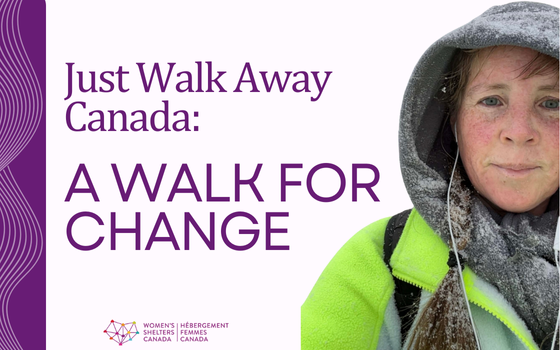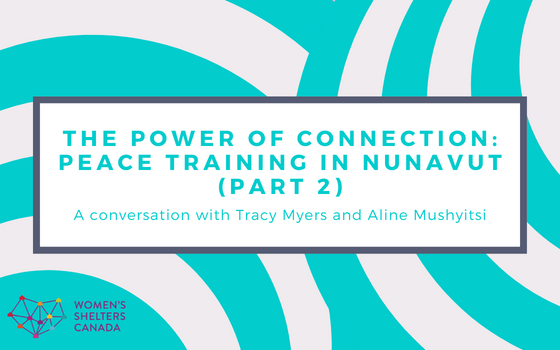In 2019, Women’s Shelters Canada (WSC) launched a new project to explore whether the collaborative safety planning process known as Circles of Safety, developed in Prince Edward Island (PEI), could be useful in rural, remote, northern, and Indigenous communities elsewhere in the country. Through this project, WSC worked with Justice Options for Women Inc., the original creators of the Circles of Safety model, to train and support teams from three shelters in adapting and implementing Circles of Safety in their community.
Despite many disruptions and delays caused by the COVID-19 pandemic, the three shelter teams worked hard to incorporate aspects of this model into their work. To mark the formal end of the project in March 2024, WSC’s Knowledge Exchange Coordinator, Chandra Saha, sat down with Gloria Dennis of Justice Options for Women, Leah Stuart-Sheppard of Women’s Shelters Canada, and Karen Sanderson of Piwapan Women’s Centre in La Ronge, Saskatchewan to reflect on the highs and lows of the project.
Chandra Saha: Gloria, to start, could you tell us what Circles of Safety are and where the idea came from?
Gloria Dennis: Circles of Safety is a collaborative safety-planning process that puts the woman who needs the safety plan at the core of the planning process. The first Circle started out of a need that wasn’t being met. There was a woman who was quite fearful for her life and although she was connected to all kinds of services, the services weren’t communicating with one another and she didn’t feel supported. Kirsten Lund, who taught interest-based conflict resolution at the University of PEI, and I had a conversation about how we could address this gap. Kirstin brought all of the woman’s supports together around the same table. We included professional supports but also people that normally wouldn’t sit in on safety planning, like her neighbour, a relative, her employer, and her mental health counselor. By bringing everyone together, everyone got the same information and all participants gained knowledge about the mandates and limitations of each service. We then worked out how we could collaboratively support this person and develop a comprehensive safety plan. And that’s how the first Circle of Safety was born.
CS: That’s so interesting. Leah, can you tell us why Women’s Shelters Canada decided to share this practice more widely?
Leah Stuart-Sheppard: At WSC, one of our roles as a national organization is to help share practices that are successful in one area of the country with shelters and organizations in other parts of the country. We heard that Circles of Safety was working well for women in PEI who were in high-risk situations, and wondered if it could be helpful in other parts of the country, and particularly in rural, remote, northern, and Indigenous communities where rates of violence are often higher. We received funding from Women and Gender Equality Canada to pilot this promising practice with three shelters to see whether this collaborative, successful model from PEI could be adapted to meet the needs of survivors in their communities.
CS: Karen, Piwapan Women’s Centre was one of the three shelters that participated in this project. Can you tell us what Circles of Safety ended up looking like for you?
Karen Sanderson: Well, we had a lot of challenges. It was really hard to start a new process during COVID, and we also had challenges with being short staffed. We also found that not a lot of the women we work with wanted to participate in a full Circles of Safety process. But, thinking about how to implement Circles of Safety really helped us bring back the concept of the wrap-around program. We integrated the concept of Circles of Safety in our case plan development and used the interest-based process to identify what women want and what support system is available. This worked really well. We could pick the right resource for them at the right time, rather than a generic case plan, and have the women develop the plan for themselves by discussing what their needs are.
CS: Gloria, Karen mentioned the interest-based process, and we know that is one of the key foundations of the Circles of Safety process. What is interest-exploring and how can it be useful to shelter work?
GD: The interest-based approach is about getting to the interests and values of the people who are at the table, rather than jumping to the solutions. We explore what’s important to the person who needs the safety plan and then we get creative and brainstorm about how we might be able to meet that interest. So, for example, a professional might say “you really need to move,” but maybe the woman wants to stay in her community. The professional’s interest is in her safety, but the woman also has an interest in staying where she has supports and stability. So we would look at how we can meet the interest of safety and the interest for the woman to feel supported at the same time. And knowing what interests and values we’re trying to meet means that if one solution doesn’t work, we can pivot quickly.
CS: Another important part of the Circles of Safety concept is collaboration among service providers. Karen, can you tell us more about the value of this collaboration and how that has changed for you during this project?
KS: We have really strengthened the communication with each agency. After a referral, we check in to see how it’s going and whether we need to help in any way to make it work better. Or if the agency is too busy because there’s been a lot of short staffing after COVID, we are able to have other agencies come and see the clients. So it’s really strengthened those relationships.
CS: For all of you, now that the project is wrapping up, what stands out to you in terms of lessons learned and what are your biggest takeaways?
GD: Well, first, don’t start a project at the beginning of a pandemic! But beyond that, each community is a little bit different and each client is a little bit different, so there has to be adaptability. Each community needs to pull from what they have available and it may look quite different from what I can offer in PEI. At the same time, some of the skill sets, like interest-exploring, can be used all across the board with clients or in staff meetings or in meetings with other service providers.
LSS: I agree! Each community has its own context, its own reality, its own challenges and barriers. Something that works in one place is not going to work exactly the same way in another place. When we’re sharing at a national level, we have to focus on each community taking what works for them and leaving what doesn’t.
KS: I think the takeaway from the whole project is putting more mindfulness into working with each client on their own needs, at their level and their interest and their time. Putting more mindfulness into what agency will work with them. Making them feel more empowered by having them have a say in their case plan and giving them the power to decide what they need. Asking ourselves “OK, we’ve done the referral, but what else have we done? How can we follow up? How can we make them more secure in their situation and in their own strengths? And, how do we build up those strengths?”
CS: Thank you all!





